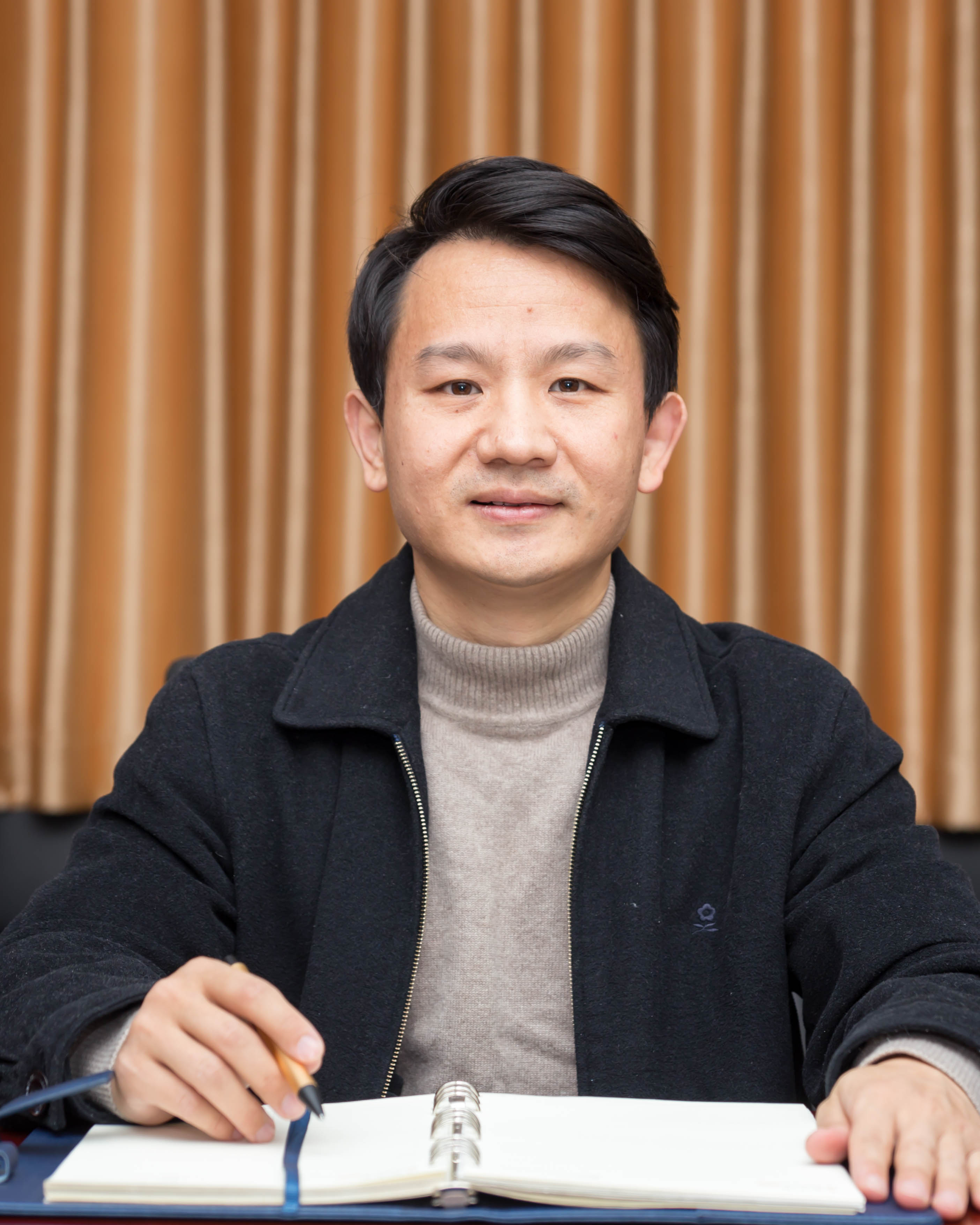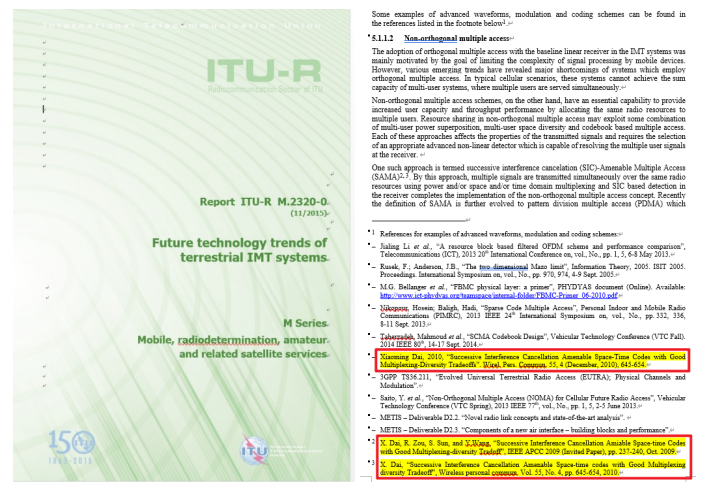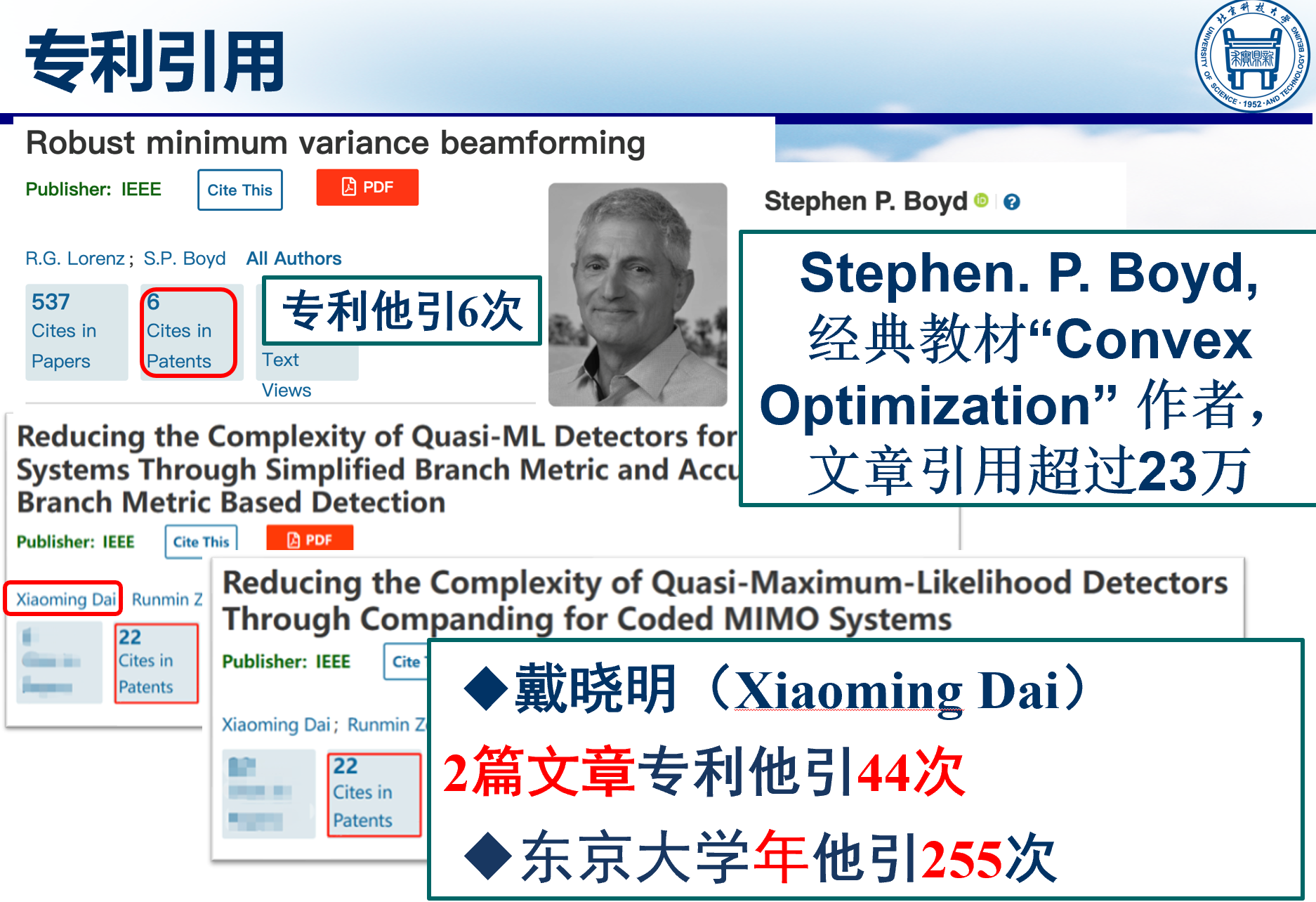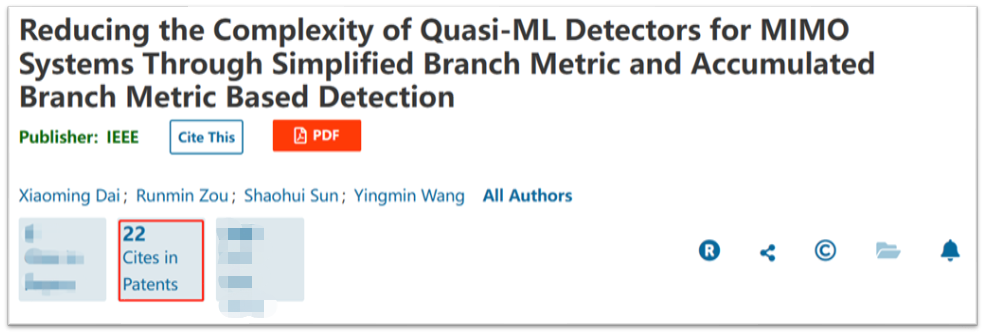
Dai xiaoming
戴晓明,北京科技大学计算机与通信工程学院教授、博士生导师,IMT-2020(5G)新型多址接入技术组副组长,无线通信与信号处理实验室主任,研究方向:6G关键技术、语音信号处理、人工智能、大数据和ASIC芯片设计等。
主要从事无线传输和接收机设计理论与关键技术方面的研究,提出“低复杂度性能无损最大似然检测(Reduced Complexity Performance-lossless Maximum Likelihood Detection)” [11][14][39]、“图样分割多址接入(Pattern Division Multiple Access, PDMA)”[37]、“复杂度受限容量可达非正交多址接入设计(Complexity-Constrained Capacity-Achieving Non-Orthogonal Multiple Access Design)”[1]和“图样分割随机接入(Pattern Division Random Access, PDRA)”[3]等技术。
1)学术研究相关工作
以第一作者身份发表学术论文30余篇,其中IEEE Trans. Commun.,IEEE Wireless Commun.等SCI文章10余篇(JCR一二区期刊8篇),以通信作者身份发表学术论文20余篇,申请/授权国内国际发明专利30余项。研究成果[15][41]被国际电信联盟(International Telecommunications Union, ITU)“未来地面无线通信技术发展趋势(Future Technology Trends of Terrestrial IMT Systems)”报告引用(页码6)[54];研究成果[41]被华为2013全球创新计划研究项目(项目编号:IRP-2013-01-02,页码8)作为唯一参考文献引用[56];在文献[11]中提出一种将最大似然(Maximum Likelihood, ML)检测算法复杂度降低一个数量级,性能仍然保持一致(数学上等价)的简化ML检测算法,检测方面的研究成果被韩国Sejong大学电子工程系作为研究生文献阅读材料;研究成果[8][11]被欧盟第七框架计划(7th Framework Program, FP7)核心项目引用[67];研究成果[6][8]专利引用44次(东京大学他引用次数255次[69][70])。
2)实际应用相关工作
2006年所提出的蜂窝系统导频设计方案被4G核心物理层标准采纳;2013年在文献[37]中提出“图样分割多址接入(Pattern Division Multiple Access, PDMA)”技术;2018年在文献[1]中提出“复杂度受限下容量可达非正交多址接入设计原则(Complexity-Constrained Capacity-Achieving Non-Orthogonal Multiple Access Design Principle)”;2021年在文献[3]中提出“图样分割随机接入(Pattern Division Random Access, PDRA)”技术。
所提PDMA技术[37]分别被IMT-2020(5G)推进组和ITU纳入5G白皮书[55]和“未来地面无线通信技术发展趋势”技术报告(页码6)[54],同时在国际标准化组织3GPP工作组关于5G的标准化会议上,该项技术被华为、中国移动、大唐电信、中兴通讯(ZTE)及展讯通信等多家通信企业的方向性技术文稿多次引用[59]-[64],被列为“国家863计划5G移动通信先期研究重大项目”重要阶段性和进展标志性成果[65](形成了以“PDMA非正交多址接入+多元LDPC编码”为代表的5G谱效提升总体技术方案),且被ITU和3GPP列为5G标准化三项主流候选多址接入方案之一;PDRA技术于2022年3月作为单独一章纳入“FuTURE论坛”《6G演进多址接入技术》白皮书[57]。在检测与估计方面工作:“性能无损低复杂度多元LDPC译码器”被IMT-2030(6G)推进组作为单独一节纳入《先进调制编码技术研究报告》[58],并作为报告的27篇基础参考文献之一被引用。在分布式信号处理方面的工作[22][21]被华为2022年技术成果转化二等奖“分布式基带架构的新型信道估计”作为项目指导文献(国内唯一单位[68])。
在担任IMT-2020(5G)新型多址接入技术组副组长期间,负责牵头IMT-2020(5G)新型多址接入技术方案征集、评估以及白皮书撰写。
3)科研项目
与国防科工局、军委装备发展部、华为、中国移动、ZTE、中国信科、是德科技(Keysight Technologies,HP仪器仪表部门)、紫光展锐、OPPO以及小米科技等通信企业就3/4/5/6G移动通信和信号处理关键技术等前沿研究多次开展合作,对产业界需求、标准制定、方案设计、产品研发以及项目管理等方面有深入理解,研究团队秉承“创新扎根实践,科研服务社会”的宗旨,在相关领域已经进行了长期积累,研究成果丰硕,热诚欢迎优秀学生及科研人员加入我们。
[1] X. Dai, Z. Zhang, S. Chen, S. Sun, and B. Bai, “Pattern Division Multiple Access (PDMA): A new multiple access technology for 5G,” IEEE Wireless Commun., vol. 25, no. 2, pp. 54-60, Apr. 2018.
[2] X. Dai, “Allele gene based adaptive genetic algorithm to the code design,” IEEE Trans. Commun., vol. 59, no. 5, pp. 1253-1259, May 2011.
[3] X. Dai, T. Yan, Q. Li, H. Li, and X. Wang, “Pattern Division Random Access (PDRA) for M2M communications with massive MIMO systems,” IEEE Trans. Veh. Technol., vol. 70, no. 12, pp.12631-12639, Dec. 2021.
[4] X. Dai, K. Higuchi, Z. Zhang, K. Long, S. Sun, and Y. Wang, “Enhancing the performance of the quasi-ML receiver (detector plus decoder) for coded MIMO systems via statistical information,” IEEE Trans. Veh. Technol., vol. 65, no. 5, pp. 3765-3771, May 2016.
[5] X. Dai, Z. Zhang, K. Long, S. Sun, and Y. Wang, “Unequal error correcting capability aware iterative receiver for (parallel) turbo coded communications,” IEEE Trans. Veh. Technol., vol. 63, no. 7, pp. 3446-3451, Sept. 2014.
[6] X. Dai, R. Zou, S. Sun, and Y. Wang, “Reducing the complexity of quasi-maximum-likelihood detectors through companding for coded MIMO systems,” IEEE Trans. Veh. Technol., vol. 61, no. 3, pp. 1109-1123, Mar. 2012.
[7] X. Dai, H. Zhang, and Y. Wang, “New sequence design criteria for multipath channels,” IEEE Trans. Veh. Technol., vol. 58, no. 8, pp. 4149-4158, Oct. 2009.
[8] X. Dai, R. Zou, S. Sun, and Y. Wang, “Reducing complexity of quasi-ML detectors through simplified branch metric and accumulated branch metric based detection,” IEEE Commun. Lett., vol. 17, no. 5, pp. 916-919, May 2013.
[9] X. Dai, “Enhancing the performance of the SIC-MMSE iterative receiver for coded MIMO systems via companding,” IEEE Commun. Lett., vol. 16, no. 6, pp. 921-924, Jun. 2012.
[10] X. Dai, R. Zou, S. Sun, and Y. Wang, “Transceiver impairments on the performance of the LMMSE-PIC iterative receiver and its mitigation,” IEEE Commun. Lett., vol. 17, no. 8, pp. 1536-1539, Aug. 2013.
[11] X. Dai, S. Sun, and Y. Wang, “Reduced-complexity performance-lossless (quasi-) maximum-likelihood detectors for S-QAM modulated MIMO Systems,” Electronics Lett., vol. 49, no. 11, pp. 724-725, May 2013.
[12] X. Dai, T. Yan, Y. Dong, Y. Luo, and H. Li, “Low-complexity joint weighted neumann series and gauss-seidel soft-output detection for massive MIMO systems,” Wireless Pers. Commun., vol. 120, no. 4, pp. 2802-2811, Oct. 2021.
[13] X. Dai, Z. Zhang, L. Dai, and B. Bai, “A low-complexity hardware-friendly DFT-based channel estimator for the LTE uplink channel,” Wireless Pers. Commun., vol. 97, no. 4, pp. 4813-4825, Aug. 2017.
[14] X. Dai, S. Sun, and Y. Wang, “Reduced-complexity (quasi-) maximum-likelihood detectors with no performance degradation for S-QAM modulated MIMO systems,” Wireless Pers. Commun., vol. 66, no. 4, pp. 613-6273, Oct. 2012.
[15] X. Dai, “Successive interference cancellation amenable space-time codes with good multiplexing-diversity tradeoff,” Wireless Pers. Commun., vol. 55, no. 4, pp. 645-654, Oct. 2010.
[16] H. Li, Y. Dong, C. Gong, X. Wang and X. Dai*, “Decentralized Groupwise Expectation Propagation Detector for Uplink Massive MU-MIMO Systems,” IEEE Internet of Things J., vol. 10, no. 6, pp. 5393-5405, 15 March15, 2023. (*Corresponding author)
[17] H. Li, C. Gong, Q. Li, S. Hao, X. Wang and X. Dai*, “OTFS-PDMA Scheme with EPA-Based Receivers for High-Mobility IoT Networks”, IEEE Trans. Wireless Commun., 2023. DOI: 10.1109/TWC.2023.3323559 (*Corresponding author)
[18] C. Gong, H. Li, S. Hao, K. Long and X. Dai*, “Active RIS Enabled Secure NOMA Communications With Discrete Phase Shifting”, IEEE Trans. Wireless Commun., 2023. DOI: 10.1109/TWC.2023.3309006 (*Corresponding author)
[19] Z. Zhang, C. Gong, Y. Dong, X. Wang, and X. Dai*, “Expectation propagation aided signal detection for uplink massive generalized spatial modulation MIMO systems,” IEEE Trans. Wireless Commun., vol. 21, no. 3, pp. 2006-2018, Mar. 2022. (*Corresponding author)
[20] H. Li, Y. Dong, C. Gong, X. Wang and X. Dai*, “Gaussian Message Passing Detection With Constant Front-Haul Signaling for Cell-Free Massive MIMO,” IEEE Trans. Veh. Technol., vol. 72, no. 4, pp. 5395-5400, April 2023. (*Corresponding author)
[21] Z. Zhang, Y. Dong, K. Long, X. Wang, and X. Dai*, “Decentralized baseband processing with gaussian message passing detection for uplink massive MU-MIMO systems,” IEEE Trans. Veh. Technol., vol. 71, no. 2, pp. 2152-2159, Feb. 2022. (*Corresponding author)
[22] Z. Zhang, H. Li, Y. Dong, X. Wang, and X. Dai*, “Decentralized signal detection via expectation propagation algorithm for uplink massive MIMO systems,” IEEE Trans. Veh. Technol., vol. 69, no. 10, pp. 11233-11240, Oct. 2020. (*Corresponding author)
[23] H. Li, Y. Dong, C. Gong, Z. Zhang, X. Wang and X. Dai*, “A Non-gaussianity-aware receiver for impulsive noise mitigation in underwater communications,” IEEE Trans. Veh. Technol, vol. 70, no. 6, pp. 6018-6028, Jun. 2021. (*Corresponding author)
[24] C. Gong, X. Yue, Z. Zhang, X. Wang, and X. Dai*, “Enhancing physical layer security with artificial noise in large-scale NOMA networks,” IEEE Trans. Veh. Technol., vol. 70, no. 3, pp. 2349-2361, Mar. 2021. (*Corresponding author)
[25] C. Gong, X. Yue, X. Wang, X. Dai*, R. Zou, and M. Essaaidi, “Intelligent reflecting surface aided secure communications for NOMA networks,” IEEE Trans. Veh. Technol., vol. 71, no. 3, pp. 2761-2773, Mar. 2022. (*Corresponding author)
[26] Y. Dong, H. Li, C. Gong, X. Wang and X. Dai*,“An Enhanced Fully Decentralized Detector for the Uplink M-MIMO System,” IEEE Trans. Veh. Technol., vol. 71, no. 12, pp. 13030-13042, Dec. 2022. (*Corresponding author)
[27] Y. Dong, H. Li, X. Wang, X. Dai* and K. Long, “Robust Expectation Propagation Detector in Impulsive Noise Channel,” IEEE Syst. J., vol. 17, no. 2, pp. 2049-2052, Jun. 2023. (*Corresponding author)
[28] Z. Zhang, C Gong, H. Li, Y. Dong, X. Wang, and X. Dai*, “Soft-input soft-output detection via expectation propagation for massive spatial modulation MIMO systems,” IEEE Commun. Lett., vol. 25, no. 4, pp. 1173-1177, Apr. 2021. (*Corresponding author)
[29] H. Li, Y. Dong, C. Gong, Z. Zhang, X. Wang, and X. Dai*, “Low complexity receiver via expectation propagation for OTFS modulation,” IEEE Commun. Lett., vol. 25, no. 10, pp. 3180-3184, Oct. 2021. (*Corresponding author)
[30] Y. Dong, H. Li, Z. Zhang, X. Wang, and X. Dai*, “Efficient EP Detectors Based on Channel Sparsification for Massive MIMO Systems” IEEE Commun. Lett., vol. 24, no. 3, pp. 539-542, Mar. 2020. (*Corresponding author)
[31] Y. Dong, C. Gong, Z. Zhang, X. Wang, K. Long, and X. Dai*, “Low-complexity EP receiver based on location-aware and reliability-aware strategy,” IEEE Commun. Lett., vol. 25, no. 6, pp. 2034-2038, Jun. 2021. (*Corresponding author)
[32] H. Zhuang, J. Li, W. Geng, and X. Dai*, “Duplexer design for full-duplex based wireless communications,” China Commun., vol.13, no.11, pp.1-13, Nov. 2016. (*Corresponding author)
[33] B. Zhong, J. Zhang, Q. Zeng, and X. Dai*, “Coverage probability analysis for Full-Duplex relay aided Device-to-Device communications networks,” China Commun., vol.13, no.11 pp.60-67, Nov. 2016. (*Corresponding author)
[34] X. Sun, D. Zhang, and X. Dai*, “Performance analysis of Full-Duplex based two-way relaying” China Commun., vol.13, no.11, pp.35-48, Dec. 2016. (*Corresponding author)
[35] H. Li, Y. Dong, C. Gong, Z. Zhang, X. Wang, and X. Dai*. “A Low-Complexity Precoding Scheme for Downlink Massive MU-MIMO Systems with Low-Resolution DACs,” Wire. Personal Commun., pp. 3627-3640, May. 2022. (*Corresponding author)
[36] C. Gong, X. Dai*, J. Cui, and K. Long, “Performance Analysis of Distributed Reconfigurable Intelligent Surface Aided NOMA Systems,” Wire. Personal Commun., May. 2023. (*Corresponding author)
[37] X. Dai, S. Chen, S. Sun, et. al “Successive interference cancelation amenable multiple access (SAMA) for future wireless communications,” in Proc. IEEE ICCS, Macau, China, 2014, pp. 222-226.
[38] X. Dai, Y. Yu, C. Sun, S. Sun and Y. Wang, “Shedding new light on sequence design criteria for multipath channels,” in Proc. IEEE ICC, Dresden, Germany, 2009, pp. 1-6.
[39] X. Dai, “Low-complexity maximum-likelihood-based QRD-M for MIMO systems with S-QAM or APSK,” in Proc. IEEE ICC, Cape Town, South Africa, 2010, pp. 1-6.
[40] X. Dai, S. Sun, and Y. Wang, “Two high-rate space-time codes for three and four transmit antennas with good diversity-multiplexing tradeoffs,” in Proc. the 5th International ICST Conference on Communications and Networking in China, Beijing, 2010, pp. 1-5.
[41] X. Dai, S. Sun, and Y. Wang, “Successive interference cancellation amiable space-time codes with good multiplexing-diversity tradeoff,” in Proc. the 15th Asia-Pacific Conference on Communications, 2009, pp. 237-240.
[42] X. Dai, Yong, B, and L. Chen, “Shedding new light on merit factor,” VTC Spring 2008 - IEEE Vehicular Technology Conference, 2008, pp. 1776-1780.
[43] X. Gao, L. Dai, Y. Zhang, T. Xie, X. Dai, and Z. Wang, “Fast channel tracking for Terahertz beamspace massive MIMO systems” IEEE Trans. Vehi. Tech., vol. 66, no. 7, pp.5689-5696, Jul. 2017.
[44] Q. Chen, Z. Wang, C. Ma, X. Dai and D. W. K. Ng, "General Recursive Least Square Algorithm For Distributed Detection In Massive MIMO," IEEE Trans. Vehi. Tech., 2024.
[45] L. Ma,S. Tong,H. Zheng, B. Bai, and X. Dai, “Edgewise Serial Message Passing Detection of Uplink SCMA Systems for Better User Fairness and Faster Convergence Rate,” IEEE Commun. Lett., vol. 8, no. 4, pp. 1285-1288, Aug. 2019.
[46] T. Xie, L. Dai, X. Gao, X. Dai, Y. Zhao, “Low-Complexity SSOR-Based precoding for massive MIMO systems,” IEEE Commun. Lett., vol. 20, no. 4, pp. 744-747, Apr. 2016.
[47] Z. Zhang, J. Wu, X. Ma, Y. Dong, Y. Wang, S. Chen, and X. Dai*, “Reviews of recent progress on low-complexity linear detection via iterative algorithms for massive MIMO systems” IEEE /CIC ICCC Workshops, 2016, pp. 1-6. (*Corresponding author)
[48] 戴晓明,庞立卓,常争,张馨月,邢怡然,王曦元. 面向 mMIMO 系统的模式分割随机接入方案[J].电信科学,2022,38(10):57-66.
[49] 李华,郝诗雅,巩彩红,李倩倩,戴晓明*.面向 6G 的新型多址与波形技术[J].电信科 学,2022,38(10):36-45. (*Corresponding author)
[50] 董园园, 张钰婕, 李华, 王春雷, 刘晓菲, 戴晓明*. 面向5G的非正交多址接入技术[J]. 电信科学, 2019, 35 (07): 27-36. (*Corresponding author)
[51] 董园园, 巩彩红, 李华, 戴晓明*. 面向6G的非正交多址接入关键技术[J]. 移动通信, 2020, 44 (6): 57-62. (*Corresponding author)
[52] 李华, 董园园, 巩彩红, 戴晓明*等. 面向车联网的非正交多址接入关键技术研究[J]. 移动通信, 2020, 44 (11): 02-07. (*Corresponding author)
[53] 张振宇, 邹润民, 惠峥, 闫甜甜, 张雨轩, 戴晓明*. 面向6G超大规模MIMO系统分布式基带处理信号检测算法[J]. 移动通信, 2021, 45 (4): 16-20. (*Corresponding author)
[54] 大唐电信集团, “一种新型非正交多址接入方案”, IMT-2020(5G)推进组, IMT-2020_ TECH_1308, Apr. 2013.
[55] https://www.itu.int/dms_pub/itu-r/opb/rep/R-REP-M.2320-2014-PDF-E.pdf.
[57] https://eecs.pku.edu.cn/info/1026/5496.htm.
[58] 未来移动通信论坛|FuTURE论坛5G/6G SIG工作组2022年第一次工作组会议在北京召开 (future-forum.org) http://www.future-forum.org/cn/onews.asp?id=2006.
[59] https://www.imt2030.org.cn/html/default/zhongwen/chengguofabu/yanjiubaogao/index.html?index=2
[60] 3GPP, R1-162226, Discussion on multiple access for new radio interface, ZTE, https://www.3gpp.org/ftp/tsg_ran/WG1_RL1/TSGR1_84b/Docs/R1-162226.zip.
[61] 3GPP, R1-167002, Performance analysis on the effect of spreading signature matrix in 5G NR multiple access schemes, Spreadtrum Communications, https://www.3gpp.org/ftp/tsg_ran/WG1_RL1/TSGR1_86/Docs/R1-167002.zip.
[62] 3GPP, R1-1608755, LLS results of PDMA with realistic channel estimation, CATT,
http://www.3gpp.Org/ftp/tsg_ran/WG1_RL1/TSGR1_86b/Docs/R1-1608755.zip.
[63] 3GPP, R1-1608756, SLS results of PDMA, CATT, https://www.3gpp.org/ftp/TSG_RAN/WG1_RL1/TSGR1_86b/Docs/R1-1608756.zip.
[64] 3GPP, R1-164889, Analytical Evaluation of Multiple Access and Preliminary LLS Results, CMCC, http://www.3gpp.org/ftp/tsg_ran/WG1_RL1/TSGR1_85/Docs/R1-164889.zip.
[65] 3GPP, R1-164247, Performance of LLS of PDMA, CATT, https://www.3gpp.org/ftp/tsg_ran/WG1_RL1/TSGR1_85/Docs/R1-164247.zip.
[66] http://www.gov.cn/xinwen/2016-09/26/content_5112102.htm
[67] 戴晓明, 大规模多入出系统非中心化信号检测算法. IMT2030 6G推进组. 6G无线技术组第四次会议. IMT-2030_WG_MIMO_202101006.
[68] https://massivemimo.eu/research-library/.
[69] https://sse.cuhk.edu.cn/faculty/tsunghuichang
[70] https://www.keguanjp.com/kgjp_jingji/kgjp_jj_diaocha/pt20170724094858.html
[71]https://www.keguanjp.com/kgjp_keji/kgjp_kj_etc/pt20170420111638.html
[72] https://www.imt2030.org.cn/html/default/zhongwen/chengguofabu/yanjiubaogao/index.html?index=2
[73] https://unisocdata.oss-cn-shanghai.aliyuncs.com/other/20231016/20231016150116%E7%B4%AB%E5%85%89%E5%B1%95%E9%94%906G%EF%BC%9A%E6%9C%AA%E6%9D%A5%E5%8F%AF%E6%9C%9F.pdf
【科研项目】
国家自然科学基金面上项目“大规模MIMO系统分布式基带信号检测理论与技术研究”,62371037,2024,主持。
广东省基础与应用基础研究基金面上项目“有源RIS辅助NOMA网络物理层安全通信研究”,2022A12345,2024,主持。
展讯通信项目“第六代通信物理层关键技术研究”,2021,主持。
OPPO广东移动通信有限公司 “多麦克风语音增强和分离算法研究”,2020,主持。
国家自然科学基金面上项目“基于稀疏编码基础理论及关键技术研究”, 61871029,2019,主持。
华为技术有限公司“大规模天线与新型多址接入关键技术研究”,2018,主持。
中兴通讯股份有限公司“面向5G的基于稀疏编码矩阵的非正交多址研究”,2018,主持。
北京科委 “面向连续广域覆盖场景的5G新型多址接入关键技术研究”,2017,主持。
电信科学技术研究院“新型多址接入关键技术研究”,2017,主持。
北京小米移动软件有限公司“面向5G的关键技术研究”,2017,主持。
展讯通信项目“第五代通信中新型多址方案设计”,2017,主持。
国家自然科学基金重点项目“时空一致性的无线接入架构与关键技术研究”,2016,参与。
中国移动研究院项目“5G多址接入关键技术研究”,2016,主持。
大唐移动“第五代通信中新型多址方案技术”,2016,主持。
是德科技(Keysight,原安捷伦仪器)全球大学研究项目“第五代非正交多址接入方案研究”,2016,主持。
中央高校基本科研业务项目“下一代移动通信系统(5G)超密集组网关键技术研究”,2016,主持。
中国移动研究院项目“关于5G总体设计、关键技术研究及标准化-新型多址技术评估与方案设计”,2015,主持。
国家863计划重点项目“5G新型调制编码技术研究开发”, SS2015AA011303,2014,参与(排名第二)。
【突出成果】
1)PDMA被ITU发表的“未来地面无线通信技术发展趋势”引用,并被ITU和3GPP列为5G标准化三项主流候选多址接入方案之一[4]-[6]。
http://www.itu.int/dms_pub/itu-r/opb/rep/R-REP-M.2320-2014-MSW-E.docx.

2)“2013年华为创新研究计划项目需求说明书”中“基于准正交空时码和OSIC接收机的MU-MIMO配对研究”项目唯一的参考文献是基于戴晓明教授发表的论文(PDMA技术的基础)。
与华为无线首席技术官(CTO)童文讨论相关应用。
3)信号处理相关工作被OPPO公司列为全球8所大学合作计划之一。
4)2篇发表于IEEE Trans的文章专利他引44次,东京大学引用次数255次[70][71]。



研究工作被ZTE、Intel、中国移动、大唐电信和展讯等多家公司的3GPP标准化技术文稿[4]-[6]和IEEE Com. Mag. [7](他引2000余次)引用。
[1] X. Dai, et. al “Successive interference cancelation amenable multiple access (SAMA) for future wireless communications,” (invited paper) in Proc. IEEE ICCS, pp. 222-226, Nov. 2014.
[2] http://www.gov.cn/xinwen/2016-09/26/content_5112102.htm.
[3] http://www.itu.int/dms_pub/itu-r/opb/rep/R-REP-M.2320-2014-MSW-E.docx.
[4] R1-164269 Multiple access for mMTC.
[5] R1-164270 Receiver implementation for MUSA.
[6] RP-152208 UL multi-user transmission for massive MTC.
[7] “Non-Orthogonal Multiple Access for 5G: solutions, challenges, opportunities, and future research trends, ” IEEE Commun. Mag., vol. 53, no. 9, pp. 74-81, Sep. 2015.
【联系人及联系方式】
戴晓明电子邮箱:daixiaoming@ustb.edu.cn
微信:dxm-ustb
[1] 戴晓明 “数据处理方法、无线通信发送装置和无线通信接收装置” 申请号: CN200410095544.7 申请日期: 2004-11-29 公开号: CN1783762B 公开日期: 2010-04-01, 已授权
[2] 戴晓明 “一种基于信道估计的速度测量方法及装置” 申请号: CN201210359122.0 申请日期: 2012-09-24 公开号: CN102857962A 公开日期: 2013-01-02
[3] 戴晓明 “一种多输入多输出数据检测方法及装置” 申请号: CN201210361158.2 申请日期: 2012-09-25 公开号: CN102882815B 公开日期: 2015-07-01, 已授权
[4] 戴晓明 “RI确定方法和设备” 申请号: CN201110316341.6 申请日期: 2011-10-18 公开号: CN102412942B 公开日期: 2015-07-15, 已授权
[5] 戴晓明 “Code evaluating device, code evaluating method, wireless communication system, base station and mobile station” 申请号: EP1998460A4 申请日期: 2007-03-19 公开号: EP19984604A4 公开日期: 2014-07-30
[6] 戴晓明, 张艳, 徐红艳, 周海军 “一种传输、接收CDMA扩频符的方法及装置” 申请号: CN201210018894.8 申请日期: 2012-01-20 公开号: CN103220237A 公开日期: 2013-07-24, 已授权
[7] 戴晓明, 黄琛, 唐胜志 “一种信号检测的方法及装置” 申请号: CN201110067978.6 申请日期: 2011-03-21 公开号: CN102148779A 公开日期: 2011-08-10, 已授权
[8] 戴晓明, 谭凤鸣, 康绍莉, 周海军 “一种应用于CDMA系统的扩频通信方法及装置” 申请号: CN201210019195.5 申请日期: 2012-01-20 公开号: CN103220013A 公开日期: 2013-07-24
[9] 戴晓明, 黄琛, 唐胜志 “一种信道估计方法及装置” 申请号:CN201110405340.9 申请日期: 2011-12-08 公开号: CN103166877A 公开日期: 2013-06-19, 已授权
[10] 戴晓明, 董园园, 赵爽, 等. “一种非正交多址码本优化方法” 申请号: CN201810854414.9 : 申请日期: 2018-07-30
[11] 戴晓明, 马心阳, 闫甜甜, 等. “一种分布式上行多用户随机接入方法” 申请号: 202011079779.2 申请日期: 2020-10-10 公布号: CN112218366B 公布日期: 2021-08-24, 已授权
[12] 戴晓明, 闫甜甜, 王毅达, 等. “一种分布式上行多用户随机接入方法” 申请号: 202010670904.0 申请日期: 2020-07-13 公布号: CN111901889B 公布日期: 2021-09-07
[13] 戴晓明, 闫甜甜, 王毅达, 等. “一种蜂窝用户初始接入功率控制方法” 申请号: 202010641876.X 申请日期: 2020-07-06 公开号: CN111901860B 公开日期: 2021-08-31, 已授权
[14] 戴晓明 “一种用于检测数据传输和数据接收的方法及基站和用户设备” 申请号: CN201410067167.X 申请日期: 2014-02-26公开号: WO2015127885A1 公开日期: 2015-09-03, 国际专利
[15] 戴晓明 “一种数据传输、数据接收的检测方法和基站、用户设备” 申请号: CN201410030862.9A 申请日期: 2014-01-22 公开号: CN104796243B 公开日期: 2015-07-22, 已授权
[16] 戴晓明, 康绍莉, 孙韶辉 “多输入多输出(MIMO)系统、设备和系统中的信号接收方法” 申请号: CN201410395305.7 申请日期: 2014-08-12 公开号: CN105337653B 公开日期: 2019-02-01, 已授权
【17】戴晓明, 康绍莉, 孙韶辉, 孟溪 “一种空间分层传输的方法及装置” 申请号: CN201410848868.7 申请日期: 2014-12-29 公开号: CN105812090B 公开日期: 2019-06-07